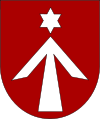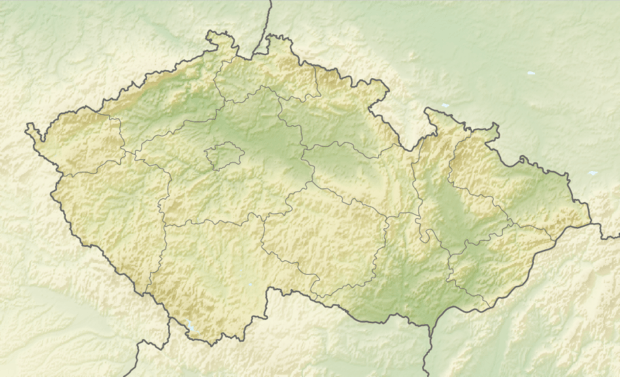Javorník (Jeseník District)
Javorník (Czech pronunciation: [ˈjavorɲiːk]) or Javorník u Jeseníku or Javorník ve Slezsku, (German: Jauernig), is a town in the Jeseník District of the Olomouc Region, Javorník Hook, Czech Republic. From 1938 to 1945 it was one of the municipalities in Sudetenland. It has about 2,900 inhabitants.
Javorník Javorník u Jeseníku | |
|---|---|
Town | |
Jánský vrch Castle (Johannesberg) | |
 Flag  Coat of arms | |
| Etymology: maple forest/hill/stream | |
 Javorník Location in the Czech Republic | |
| Coordinates: 50°23′39″N 017°00′22″E | |
| Country | Czech Republic |
| Region | Olomouc |
| District | Jeseník |
| Founded | 14th century |
| Government | |
| • Mayor | Jiří Štrajt |
| Area | |
| • Total | 77.43 km2 (29.90 sq mi) |
| Elevation | 295 m (968 ft) |
| Population (2006-10-02) | |
| • Total | 3,014 |
| • Density | 39/km2 (100/sq mi) |
| Time zone | UTC+1 (CET) |
| • Summer (DST) | UTC+2 (CEST) |
| Postal code | 790 70 |
| Website | www.mestojavornik.cz |
History
Early history
The town, which lies in the foothills of Rychlebské Hory (German: Reichensteiner Gebirges), was established under a medieval fortress, what would later become castle Johannesberg, at the beginning of the 14th century. It belonged to the principality of Neisse-Grottkau, which was under the rule of the prince-bishops of Breslau.
From 1428 until 1432, during the Hussite Wars, Javorník and its fort were under siege by the Hussites. They left the village and the fortress in ruins, and it was not until the early 16th century when Jan Thurzo, Prince-Bishop of Breslau, built the castle Johannesberg on the remains of the old stronghold of Jauernig. During his reign Javorník gained importance as a mining settlement as several silver and iron ore mines were established in the area. In 1549 the village finally became a town and a first school was also established. Unfortunately, in 1576 the town’s growth was hampered as it was ravaged by a fire. The devastation was minor however, compare to the destruction Javorník experienced during the Thirty Years War, especially then in 1646. The settlement was nearly completely destroyed and it was not until eight years later that Javorník became once again a prosperous town, now with a church, school, town hall and a brewery.
Golden Age
After the Prussian victory in the First Silesian War in 1742, Austria lost nearly all of its Silesian possessions. However, Javorník together with the so-called Bohemian Silesia remained under Habsburg control. This was a prosperous period for the town. In 1748, Javorník became the seat of the Breslau diocese responsible for the administration of all its properties in the Freiwaldau region and since 1767 also the center of Habsburg government for the principality of Neisse-Grottkau. At the same time, Count Philipp Gotthard of Schaffgotsch, the prince-bishop of Breslau moved his court on the Johannesberg castle and with him Javorník became also the cultural center of Upper Silesia. Among the most famous personalities living there was August Carl Ditters von Dittersdorf, renowned Viennese composer and violinist. By 1804, Javorník had 419 homes and over 3100 citizens, more than any other urban area in the region.
19th and early 20th century
In 1825 a devastating fire once again ravaged the town, destroying 104 of its structures including the town hall, church and most of its industry. Although Javorník was rebuilt, it never regained the same importance in the region as it had during the golden age in the second half of the 18th century. Most of the textile, brewing and manufacturing industries never fully recovered and the city became once again dependent on forestry and mining, chiefly of silver, arsenic and iron. In 1897, Javorník was linked with the rest of the Austro-Hungarian Empire by a local railway, but even that did not revitalize the town’s industries or its overall growth. In 1880 Javorník had the population of 3,362 citizens, all were German-speaking. This number continued to decline throughout the first quarter of the 20th century. During WWII, approximately 30 French and Soviet POWs were interned at the old town prison in Javorník. Other and larger POW Camps were located in Zálesí, Travná, Račí Údolí and the nearby Bernartice.[1] Also located in Javorník was Reichsarbeitsdienst (RAD) work camp K6/380 (in German RAD-Abt. K6/380 Jauernig).
According to the Austrian census of 1910 the town had 2,052 inhabitants, 1,956 of whom had permanent residence there. Census asked people for their native language, 1,956 (100%) were German-speaking. Most populous religious group were Roman Catholics with 2,019 (98.4%).[2]
By 1938, local ethnic-German population became overwhelmingly pro-Nazi with many locals joining the Sudetendeutsches Freikorps, a para-military Nazi-Germany sponsored and trained organization that was conducting terrorist attacks against the Czechoslovak authorities. One of the most notable attacks of the Freikorps in the town took place on 22 September 1938. A group of 12 members of the Czechoslovak Border Guard was retreating through the town after being attacked from Germany when it was ambushed by over 100 local members of Freikorps. The Czechoslovak soldiers were disarmed and abducted to Germany where they were interned by local authorities in the concentration camp in Patschkau.[3]
Post-WWII years
After 1945, under the Beneš decrees most Sudeten Germans were forced to leave Czechoslovakia. Most citizens of Javorník were evicted from their homes and held at several internment camps in the Freiwaldau district. Many of them were also beaten and killed by numerous militias and paramilitary groups with strong ties to the Communist Party and the Red Army.[4] However, scores of families from Javorník were able to leave with the assistance of Cardinal Adolf Bertram and the Wittelsbachs, a noble German family that owned several properties in the area. They worked tirelessly to save many ethnic German families; helping them to flee Czechoslovakia to the British and US Zones in Germany and Austria. The majority of the German population was expelled from Javorník by 1947. Their property was given or sold to the Czech and Slovak citizens under the repopulation programs of the Czechoslovak government.
Following the Communist coup d'état of 1948, Czechoslovakian government confiscated most of the property which belonged to the Roman Catholic Church and the prince-bishops of Breslau, including their farmland and forest holdings. Most of the businesses closed and were moved to larger cities in the region. By the mid-1960s, the only major employers in Javorník were the JZD Czech: Jednotné zemědělské družstvo - agricultural cooperative), small manufacturer of metal furniture and a company producing stuffed toys. As the social conditions in the town continued to deteriorate, in the mid-1980s the Communist government decided to build a subsidiary of MEZ Postrelmov, one of the oldest companies in Northern Moravia, in Javornik. Unfortunately after the Velvet Revolution in 1989, the company found it hard to compete in the new economic environment and closed down in early 1990s.
As of 2008, the town of Javorník had one primary school and two kindergartens, a health centre (with two general physicians) and several leisure facilities, including a movie theatre, library and a swimming pool.[5]
Administrative parts of Javorník
The following settlements and villages are administrative parts of Javorník:[6][7]
- Bílý Potok
- Horní Hoštice
- Javorník
- Travná
- Zálesí
Famous personalities born or living in Javorník
- Count Philipp Gotthard of Schaffgotsch (1716–1795), Prince-Bishop of Breslau
- Carl Ditters von Dittersdorf (1739–1799), composer, Kapellmeister at Schloss Johannesberg from 1770 until 1794
- Johann Nepomuk Rust (1775–1840), surgeon, born at Schloss Johannesberg
- Joseph Freiherr von Eichendorff (1788–1857), poet, stayed at Schloss Johannesberg 1856/57
- Joseph Christian Freiherr von Zedlitz (1790–1862), author, born at Schloss Johannesberg
- Cardinal Melchior Freiherr von Diepenbrock (1798–1853), Prince-Bishop of Breslau
- Emil Sax (1845–1927), economist, born in Jauernig
- Cardinal Adolf Bertram (1859–1945), Archbishop of Breslau, died in Schloss Johannesberg and was buried at the Javorník cemetery, mortal remains transferred to Wrocław Cathedral in 1991.
- Franz Wittelsbach, Prinz von Bayern (1919–1999), a son of Prince Georg of Bavaria, stayed in Schloss Johannesberg 1944/45, lived in Javornik from 1944–1999 and is buried at the local cemetery.[8]
References
- 1. Zuber, Rudolf: Zajatecké tábory na Jesenicku za druhé světové války. Severní Morava, Vlastivědný sborník, sv.6, Šumperk 1961, s. 15–29
- Ludwig Patryn (ed): Die Ergebnisse der Volkszählung vom 31. Dezember 1910 in Schlesien, Troppau 1912.
- Procházka, Petr (2007), Příběhy z pohraničí (1st ed.), Jeseník: Hnutí Brontosaurus Jeseníky, p. 13
- Documents on the Expulsion of the Sudeten Germans: Survivors speak out
- Město Javorník Municipal website
- Statnisprava.cy Website of the State Administration (in Czech)
- Portál Veřějné Správy České Republiky Portal of the Public Administration of the Czech Republic (in Czech)
- Franz Wittelsbach, Prinz von Bayern
Further reading
- Gernot, Ludwig und Wolf, Kurt – Jauernig und das Jauerniger Ländchen. Das 2. Heimatbuch des ehemaligen Gerichtsbezirkes Jauernig – 1995.
- Hosák, Ladislav – Historický místopis Moravy a Slezska v letech 1848–1960 – 1967, Profil Ostrava.
- Kuča, Karel – Města a městečka v Čechách, na Moravě a ve Slezsku II. díl – 1997, Libri Praha.
- Pachl, Hans – Jauernig und das Jauerniger Ländchen. Ein Heimatbuch des ehemaligen Gerichtsbezirks Jauernig – 1983.
External links
| Wikimedia Commons has media related to Javorník (Jeseník District). |